Owning land in Maine was bound to come with adventures…and wildlife. Lots of it. Which is more exciting, the birds or the beavers?
Winter is in full swing. The roads are completely frozen and covered with a thin layer of snow that rests upon a thicker layer of ice. The bumps have formed on the surface as well. They arrive after the ground freezes beneath the asphalt and swells. What was relatively smooth a month or so ago is now nothing but stuttering vibration. That’s what it seems like to me, anyway. Our car wasn’t made for the winter. While it is all-wheel-drive and drives like a champion in most conditions, it’s suspension is super-stiff and certainly wasn’t meant for back roads.
The snow in the yard and woods is also multi-layered, which usually occurs about the time the roads get bumpy. The bottom layer is mostly ice. That forms in December. The second layer is some sort of snow that was rained on and that semi-solidly froze. That forms in early January. The top layer is powder. That forms, or falls, in mid-January. It’s the same every year. The beautiful white surface hosts nothing but danger beneath. When we walk on it, we’re able to momentarily glide across the surface with just a few inches of fluff to contend with, but more often than not, while we’re gliding, the surface of the second layer gives way and we crash through to that icy veneer below. My teeth clank and my spine compresses. It’s never a good thing and I swear I get a little shorter every time it happens.
Winter does offer a lot in the way of nature though. Laura’s trail cams have been working overtime, capturing everything from fox to fisher to rabbits to deer. And beaver. We can’t forget about the beaver, especially because that’s what I’ll be discussing in this post. But first, please allow me to tell you about the birds.
Cardinals at the Feeder
I’ve always felt that cardinals were a very dignified bird. They don’t misbehave, they usually arrive in pairs, and one, almost every single time, waits for the other to finish eating at the feeder before swooping down to gather some food for him or herself. They’re a polite bird and I think that’s a good thing. Perhaps that politeness is somehow intertwined with the fact that cardinals generally remain partners for life. Yes, there are occasions when they do break up to fly off in different directions, but by and large, you’ll see the same pair of cardinals appear at your feeder year after year.
Would you like to know what other bird types couple for life? It’s not an all-inclusive list, but it’s an interesting one: Penguins, swans, puffins, and albatrosses. Who knew? It’s been thought that loons also mate for life, but that hasn’t been borne out by the evidence.
Contrary to popular folklore, loons do not mate for life. Pair bonds last on average about seven years; they may fail when a new loon moves onto a territory and challenges the resident. Usually, but not always, these are male birds. Loons will battle to the death to defend their territories, but more often the weaker loon gives up the fight. The mate left behind typically stays on the territory. Maine Audubon
I suppose loons could stick together, given the chance. If another loon didn’t fly in to steal the entire ensemble, that is.
We had a few cardinals visit our back yard feeder this past week. A male and female who seemed to be attached at the hip. She waited in the tree while he engorged himself at the feeder. And then they switched. Things went on this way until a blue jay flew in out of nowhere. I think we all know what happens when the blue jays arrive. They take charge while everyone else flies away. And then the current occupant of the feeder makes a valiant attempt at consuming every last morsel of food.
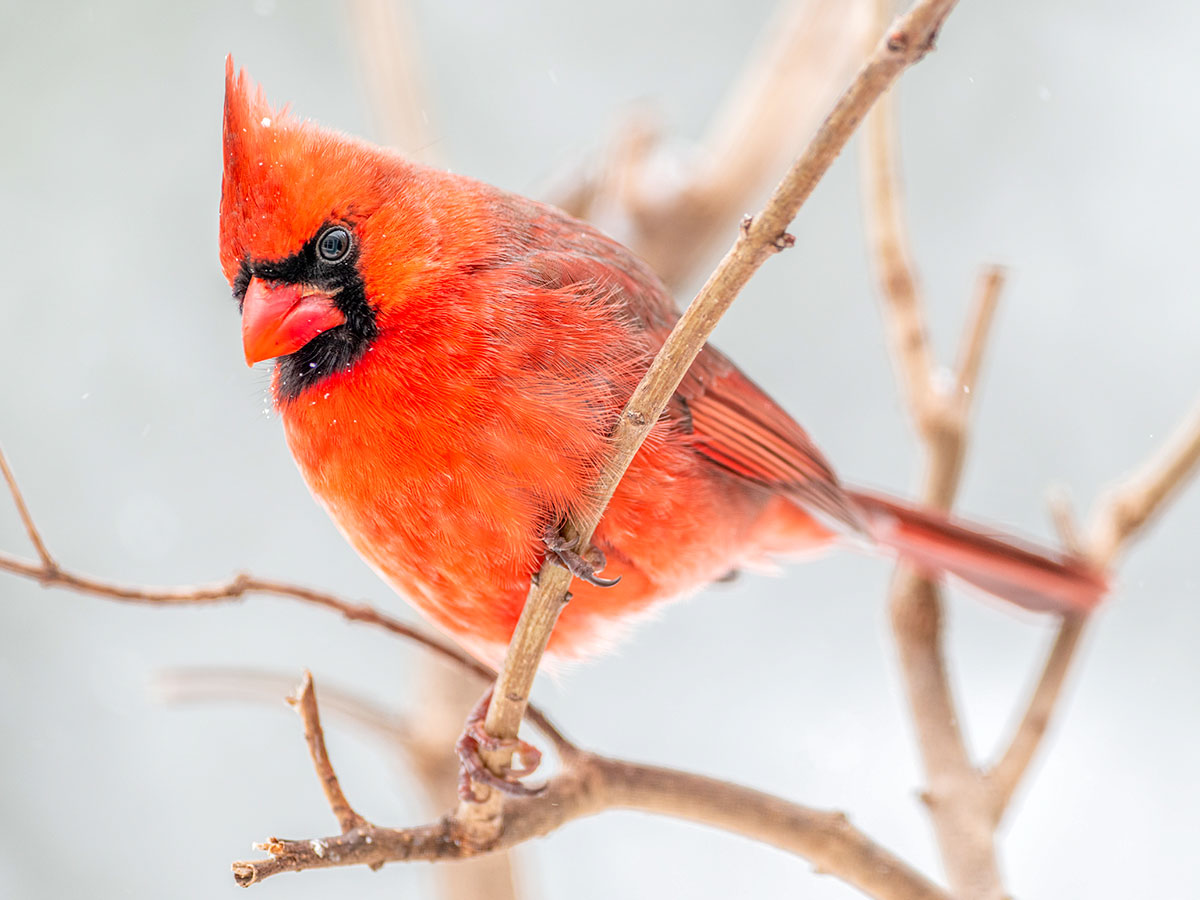
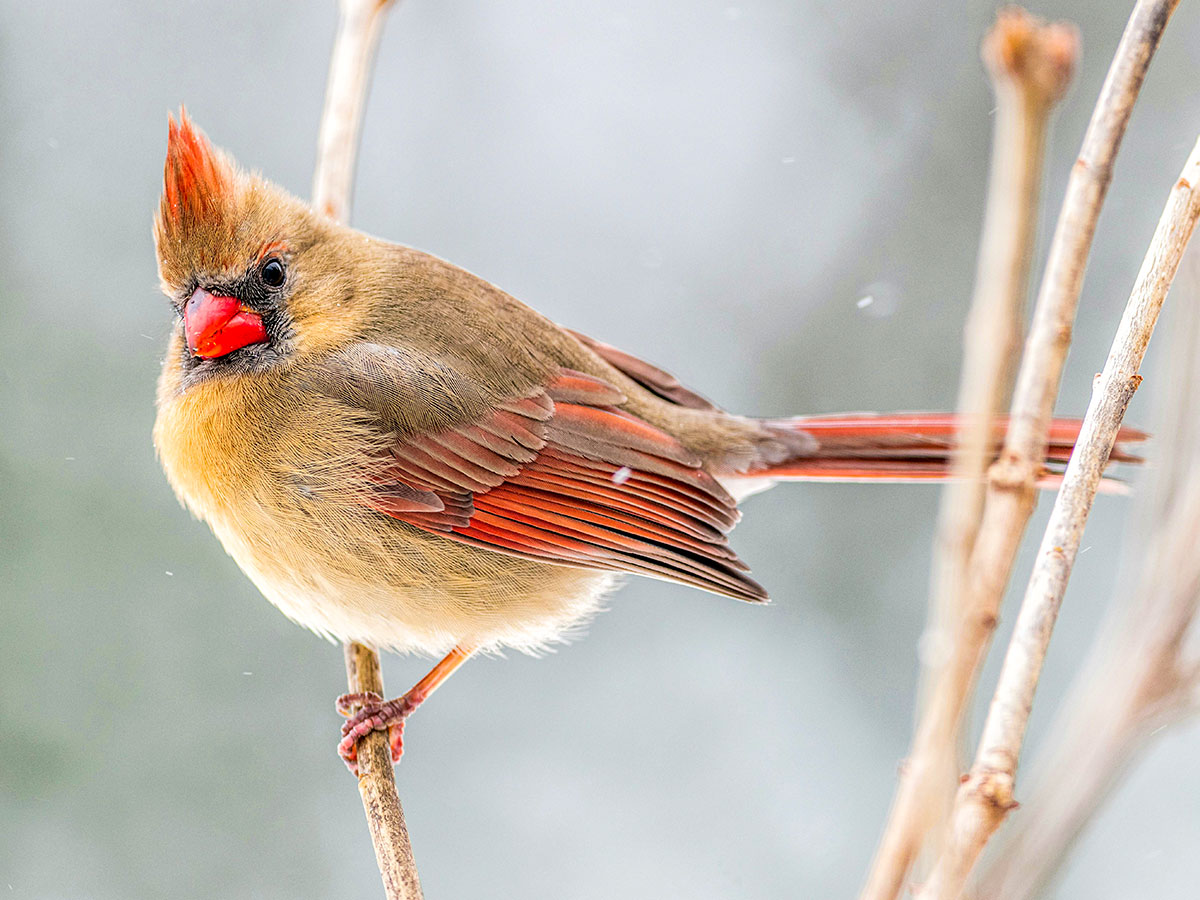
Fun fact about the Northern Cardinal: Have you ever wondered why cardinals are red and orange? Or reddish and orangish? It’s because of the food they eat. Like most other birds, cardinals are what’s referred to as “granivorous,” or grain eating. Cardinals also eat other foods though and these foods are what give the bird its trademark color. The foods include insects and wild fruits like grapes, dogwood berries, and mulberries. This ancillary diet contains carotenoids, which are pigments that are produced by plants and algae. They’re why pumpkins and carrots are orange and tomatoes, lobsters, and apparently, cardinals, are red.
Chickadees in Hand
Do you have chickadees on your property? Do you have a bird feeder? If you’ve been feeding your chickadees through the feeder and have built up a regular visiting population, I encourage you to step outside during the morning hours when the birds are most hungry, place some food in your palm, and raise that palm up high to the sky. You might be surprised to find that your chickadees are just as inclined to land on your fingertips as they are to land on your feeder. Laura has been feeding birds this way for years. I remember the first time she tried it. It was an incredible experience. Minutes after pouring some grain in her hand and offering it to the birds, those very same birds took turns darting down from a nearby tree, quickly snatching pieces of food, fluttering away, and then returning for more. It went on until Laura’s arm got tired. What an amusing event.
This is a photo I took just this week. Our chickadees have been shy as of late, but we’re trying to retrain them to stay close by. It seems like they prefer the tops of the trees for some reason. But food is food and when it’s on offer, I guess it’s tough to resist.
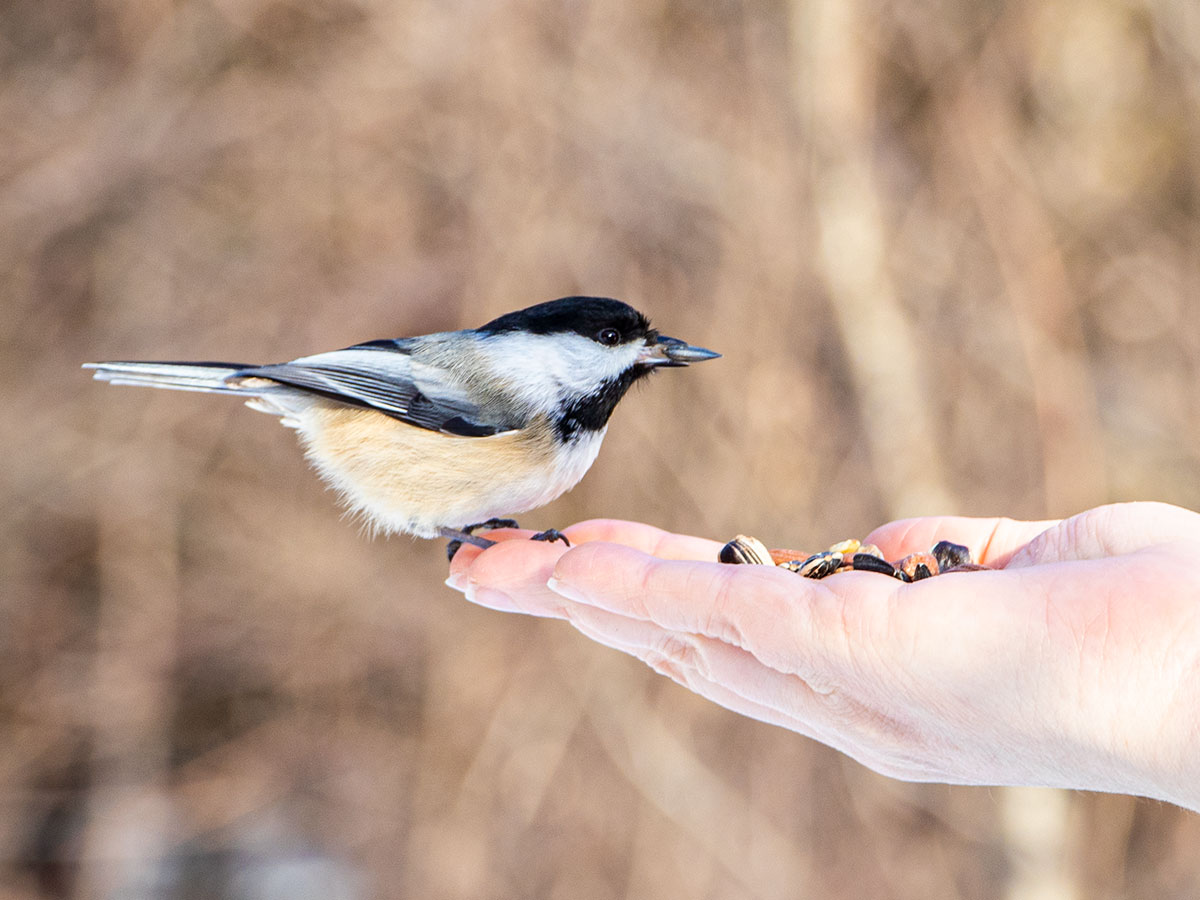
I’m not really the best bird photographer. They’re too fast for me. I’m so much more methodically driven and I prefer to shoot either time lapse or still life. Action – well, that’s Laura’s domain. While I did capture the above image, it isn’t great. Would you like to see some better photography as well as learn everything you ever wanted to know about this wonderful little creature? If so, I can lead you to Laura’s very own blog. Take a look at these titles:
- Photographing the Charming and Delightful Black-capped Chickadee
- How to Attract Black-capped Chickadees with a Variety of Foods
- The Adorable Black-capped Chickadee
- The Black-capped Chickadees Have Returned
Laura’s been birding for years and if there’s one chickadee whisperer out there, it’s her.
The Beavers
Speaking of life partners, please allow me to introduce one of the utterly cutest animals on the planet – the beaver.
There are currently over 5,000 mammals in the animal kingdom. A mere 3% of them mate for life. Have you ever wondered which ones they are? While I can’t offer the full list here, I’ll share the most popular ones: prairie voles, gibbons, wolves, and yes, beavers.
Beaver families, also known as “mated beaver pairs and their children” live in colonies. The children (kits) remain with their parents for, give or take, two years and then move on to form their own colonies. The parents remain together to live out their lives, reproducing over and over again. If one of the pair dies, the other will seek out another partner to continue the process.
Laura and I have been living in Maine for just over 10 years. During the first few, the setup was like this: one house on five acres of semi-forested land (two acres lawn, three acres trees). Time passed and an opportunity arose. Soon enough, the setup changed. It became like this: one house on 15 acres of land. What happened? We bought the parcel of land adjacent to our original property, which consisted of approximately 10 acres of forest. Now we live in a house surrounded by 15 of both grass and trees. Surrounding those 15 acres are more forests and fields, and boy, what I wouldn’t do for a few additional parcels. The one I’d really like consists of 46 acres and if we had that, we’d own a fairly sizeable chunk of local real estate. One I’d hike and cut trails through and use for firewood. I’d say I’d be quite content.
This whole thing really isn’t new. I’ve always wanted land. Since I was a child, my heart has been set on owning a whole bunch of acres in the middle of a quiet area that’s full of nature and wildlife. There’s something about the tranquility of it all. Nature, wildlife, and the sparse population of humans. I don’t mind neighbors, but I prefer to keep them at a distance. So far, things have worked out well. Laura and I have never lived so far away from not only civilization as a whole, but people next door. It’s a wonderful feeling.
This is the back corner of our property. It’s the farthest you can walk from our house, but remain on our land. Sometimes I wander back there, only to stop and think about where I’ve ended up. I marvel and the pines and the clear water.
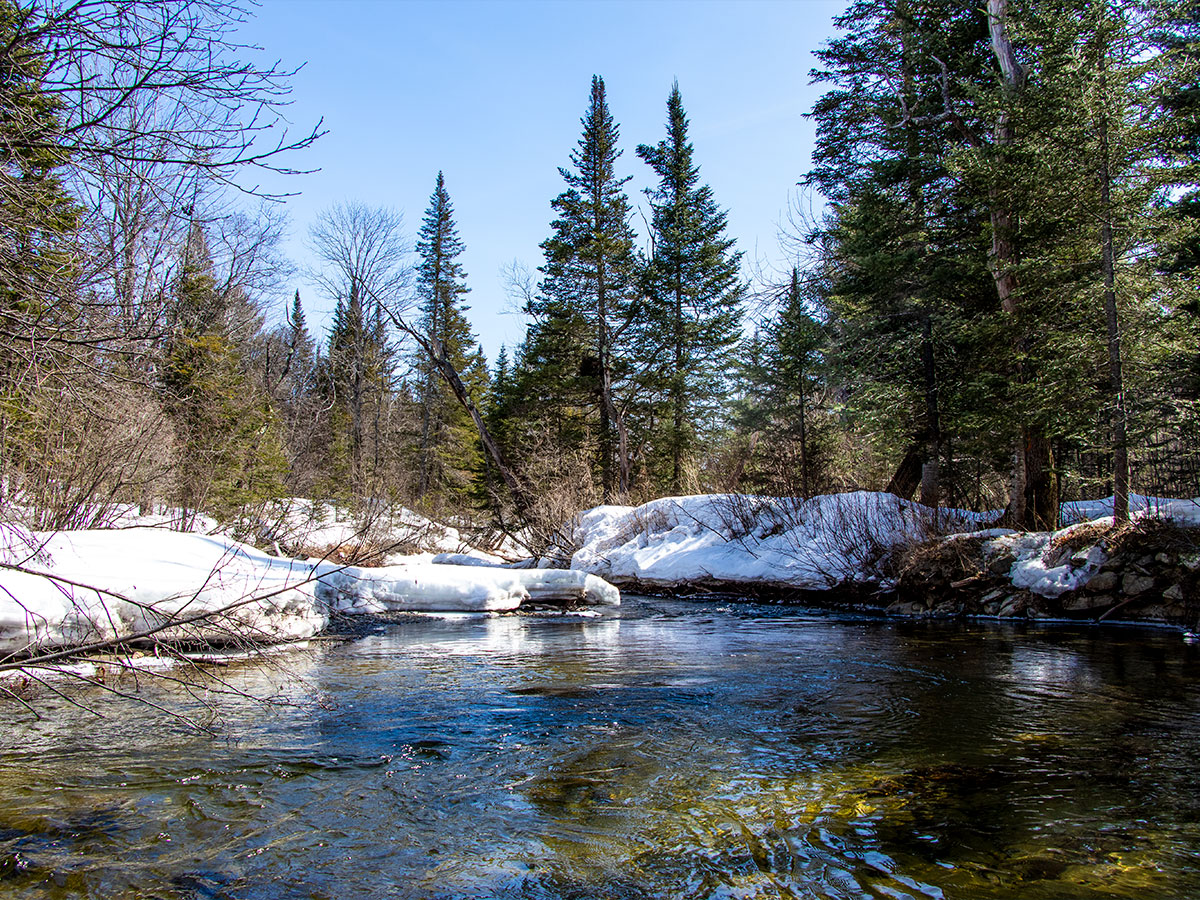
I was bitten by the land bug when I was very young. My parents owned 14 acres in the small, very picturesque, town of Amenia, New York. A few days per summer, my parents, along with my brother, sisters, and I would fill my father’s green Dodge extended cab pickup truck to venture for a day’s activity on what we termed, “The Mountain.” I’d sometimes invite friends to come with me and we’d spend our time exploring and making new paths. It was a lot of fun and it’s something I’m sure my entire family will remember forever. As the years passed though and as we all got older, the land was sold. It was a tough blow to my siblings and me. We loved that piece of property and as my parents were in the midst of selling it, I recall discussion of perhaps someday buying a different piece – this time, something that contained some water. My mother told me that she’d always wanted property with a stream on it. “Some running water would be nice. I’ve always loved running water.” Unfortunately, that new piece of property never came to pass. Rightly so because my brother and older sister had already moved out of the house and had gone off to college. Who was actually going to visit this property?
When Laura and I were looking for real estate in Maine, we weren’t looking for something that included water, per se. Finding something that featured it just happened. And now we’ve got more than we know what to do with. We have a pond, a stream that runs along the entire five acres of one boundary, and a brook that runs along another two acres. When we first arrived, we couldn’t believe our eyes. Of course, we’ve since become accustomed to being somewhat encapsulated by two of the area’s most pristine babbling brooks. And believe me when I say this; I regularly include neither of the words pristine nor babbling in everyday speech. This is a special occasion and our water is just that perfect.
Over the years, I’ve made some changes to our little forest in Maine. What was once an impassable nettled mess of broken trees lying on the soft pine needle floor has become somewhat transformed into a path-laden sanctuary for both animals and humans alike. In other words, I’ve spent a fair amount of time cleaning up the trees that had fallen and I’ve cut more than enough trails to allow us to walk freely. We enjoy the paths nearly as much as the animals do. I know this because when Laura and I venture into the forest after a snowfall, we see deer, rabbit, and fox tracks. We see them all the time and we see them consistently where I’ve cleared. We also see beaver tracks at times, and I suppose this is as good a time as ever to segue into that.
It all began last summer. During one particular walk in the woods, Laura and I visited the brook that runs along the farthest land boundary of them all – the one that lies five acres away. As we arrived at the water, I noticed some odd movement to my right. The sun had already set, so I couldn’t see too well, but once I shined my flashlight across the area of movement, I saw none other than a big brown beaver swimming toward us. The beaver saw us and submerged him or herself. He stayed there and stayed there and stayed there. We waited and he waited. I became unnerved and asked Laura to join me in leaving the area. I didn’t want the beaver to stay under the water too long and drown himself, not that that would actually happen, but I thought we were annoying him so better off we get out of there.
Fun fact: Beavers can stay submerged for up to 15 minutes. They even have translucent third eyelids, which allow them to partially see with their eyes closed.
Upon subsequent visits to the brook, we looked for that beaver. We couldn’t find him. Not until months later, far upstream. For some reason, one of us got the idea to hike a few hundreds feet up the brook, through the thick underbrush to hunt for this elusive beaver. Unfortunately, during that visit, he remained hidden. We did, however, find his dam. And it wasn’t long after Laura set up her trail cams near the dam did we once again witness the existence of the beaver himself. In all his glory.
Looking at these photos makes me think of one word and one word only. Busted!
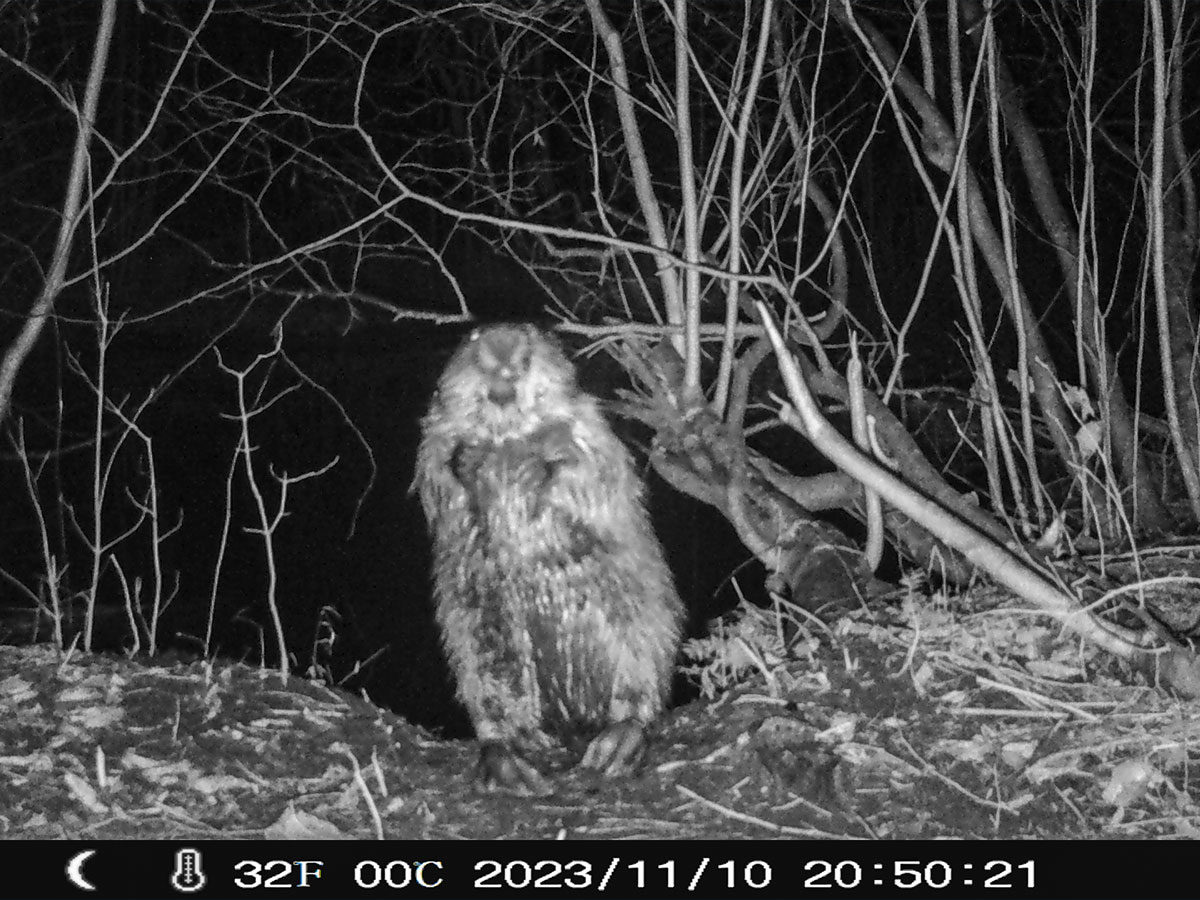
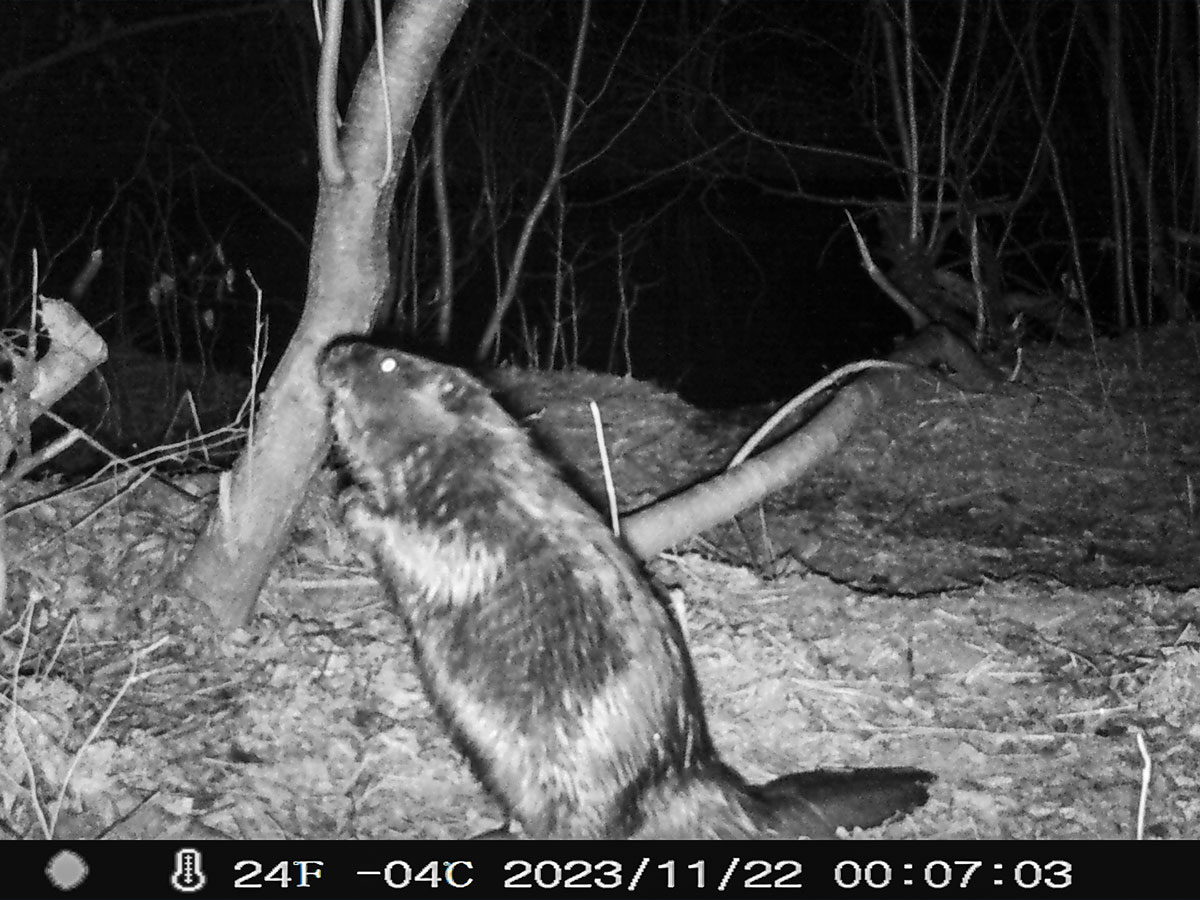
We spent weeks recording the movements of this and other beavers in the area. Laura’s got dozens of files of both photos and videos alike stored on her computer. She was gracious enough to allow me to post just a few here. Please watch the video below. It’s the best parts of three videos, combined into one. We suspect this is one beaver due to the chunk missing from the left part of his tail. In other videos, we’ve seen two additional beavers swimming with this one, so we’re confident of a colony. Also, the dam was to the right of the path down to the water (straight ahead). Unfortunately, two storms washed the dam away. The beaver is still around though. I’ll show you evidence of that below.
In the last section of the video, you can see the beaver taking the apple we left on the stump for him. He loves those apples.
For Laura’s birthday this year, I bought her a new trail cam. Over the past five or so years, she’s been steadfast with her positioning them around the forest, checking the data cards, and replacing batteries. While her first two cams were/are fine, the one I bought her is much more modern. It captures both photos and video in high resolution. Below are two photos of her cameras. An old one is on the left and the new one is on the right. These photos are also good examples of what trail cams look like when they’re set up in the woods. Just strap them to a tree or pole and you can capture on video the most unexpected things.
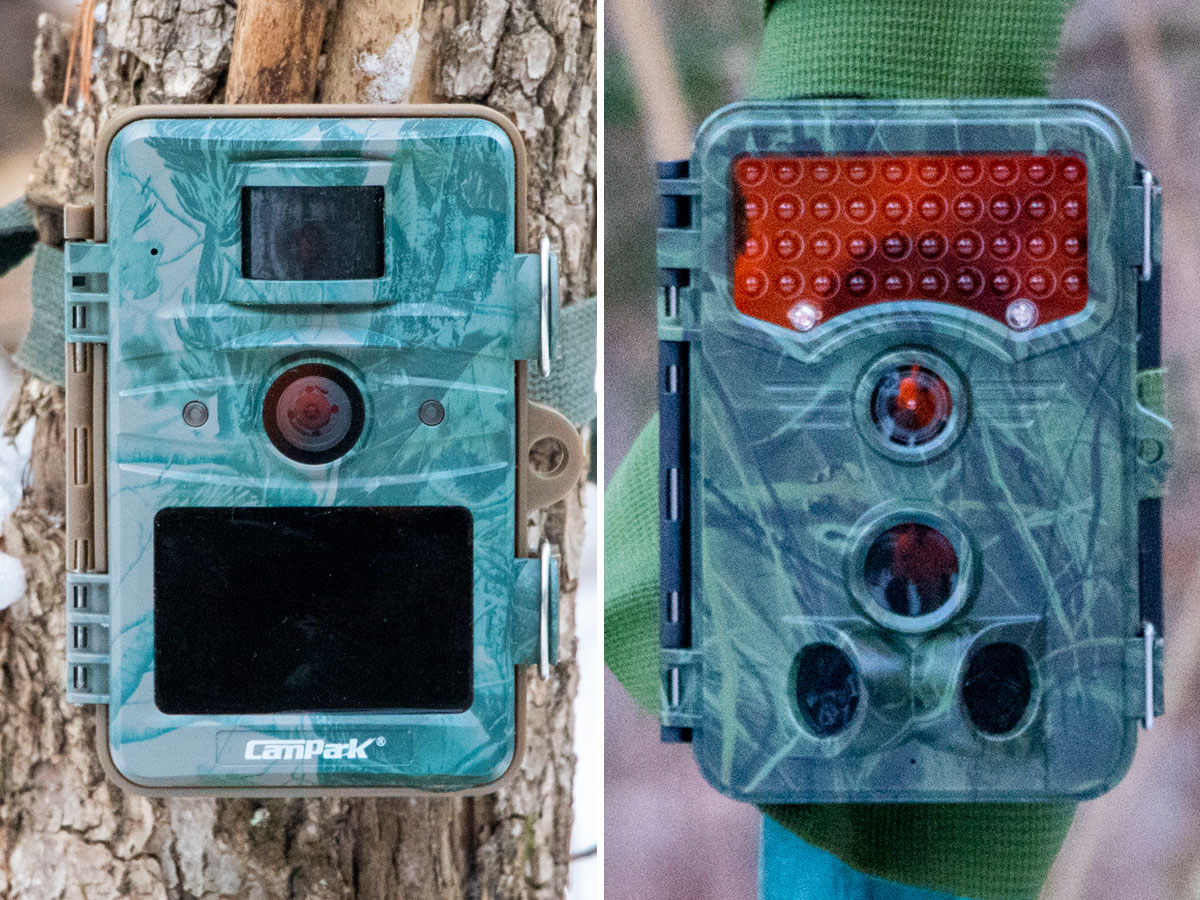
I mentioned above that we have evidence of the beaver surviving the two storms that washed his dam away. What type of evidence, you ask? Take a look. These photos were taken in the same area we originally saw him submerged under water all those months ago. Apparently, he travels. Since his food supply floated downstream during the flood, he’s been venturing out to find more. Now my smaller ash trees are disappearing.

We’ll have to see what happens with this animal. We haven’t seen any sign of him in a few weeks, so perhaps we’ll visit the site of the old dam again. He’s bound to be somewhere nearby. I’ll keep you updated.
I think the beaver story is a good one and I hope you enjoyed it. I had fun posting the video and perhaps if I get some favorable response from this one, I’ll post more. I’m sure folks who don’t live in Maine wouldn’t mind seeing some footage like it.
To close this post, I think I’ll leave you with two photos I took while capturing the bird on Laura’s hand. They’re two up-close shots of some pine needles with water droplets formed by melting snow. For some reason, I thought they were nice. Enjoy!
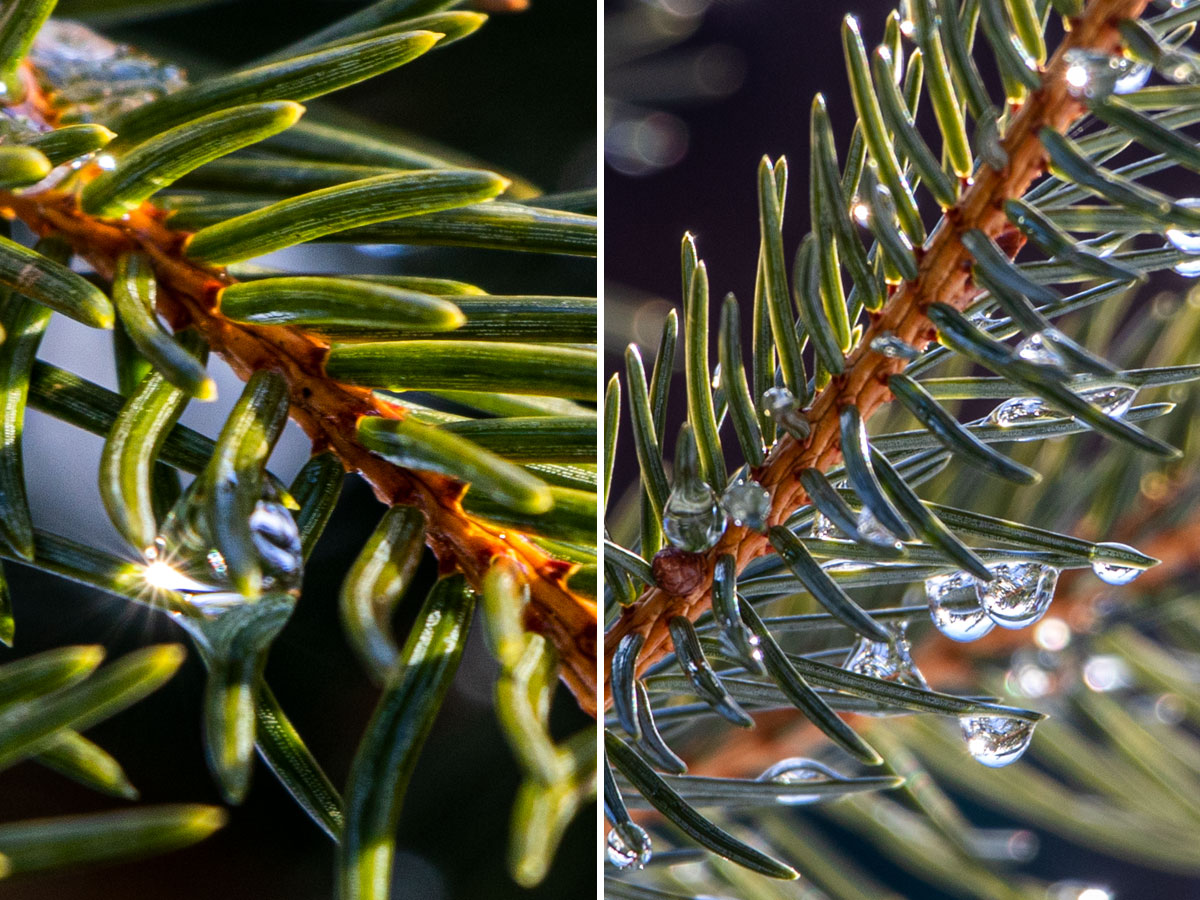
is brings me to the end of another post. I sincerely hope you enjoyed it and, if so, I invite you to leave a comment down below to let me know your thoughts. It’s always nice to get feedback on the things I share.
Below are a few questions I’d like to ask you:
- Would you like to receive these posts via email? If so, you can sign up here. I send out a new post every single Monday morning, bright and early.
- Are you new here? Are you interested in reading through my entire list of posts that go way back? If so, you can start right here.
If you did any of these things, I can tell you right now that you’d truly make my day. Thank you so much and with that, I say adieu. Or at least, until next time.
PS – Can you do me a huge favor? Can you please share this post with someone you think might enjoy it? Here are some links to make doing that easier. Thank you!

Fabulous post, Jay!
Thank you!